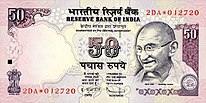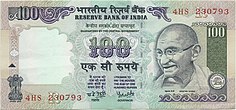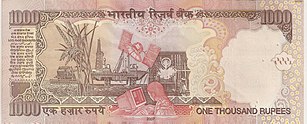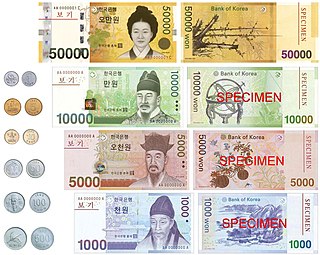
The South Korean won is the official currency of South Korea. A single won is divided into 100 jeon, the monetary subunit. The jeon is no longer used for everyday transactions, and it appears only in foreign exchange rates. The currency is issued by the Bank of Korea, based in the capital city of Seoul.

The United States one-hundred-dollar bill ($100) is a denomination of United States currency. The first United States Note with this value was issued in 1862 and the Federal Reserve Note version was first produced in 1914. Inventor and U.S. Founding Father Benjamin Franklin has been featured on the obverse of the bill since 1914, which now also contains stylized images of the Declaration of Independence, a quill pen, the Syng inkwell, and the Liberty Bell. The reverse depicts Independence Hall in Philadelphia, which it has featured since 1928.
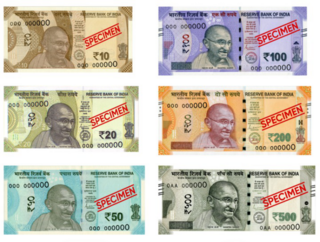
The Indian rupee is the official currency in India. The rupee is subdivided into 100 paise. The issuance of the currency is controlled by the Reserve Bank of India. The Reserve Bank manages currency in India and derives its role in currency management on the basis of the Reserve Bank of India Act, 1934.

The Mauritian rupee is the currency of Mauritius. One rupee is subdivided into 100 cents. Several other currencies are also called rupee.

Banknotes of the Philippine peso are issued by the Bangko Sentral ng Pilipinas for circulation in the Philippines. The smallest amount of legal tender in wide circulation is ₱20 and the largest is ₱1000. The front side of each banknote features prominent people along with buildings, and events in the country's history while the reverse side depicts landmarks and animals.

Security printing is the field of the printing industry that deals with the printing of items such as banknotes, cheques, passports, tamper-evident labels, security tapes, product authentication, stock certificates, postage stamps and identity cards. The main goal of security printing is to prevent forgery, tampering, or counterfeiting. More recently many of the techniques used to protect these high-value documents have become more available to commercial printers, whether they are using the more traditional offset and flexographic presses or the newer digital platforms. Businesses are protecting their lesser-value documents such as transcripts, coupons and prescription pads by incorporating some of the features listed below to ensure that they cannot be forged or that alteration of the data cannot occur undetected.
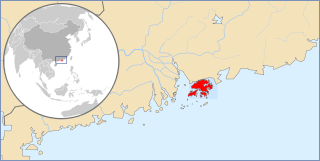
The issue of banknotes of the Hong Kong dollar is governed in the Special Administrative Region of Hong Kong by the Hong Kong Monetary Authority (HKMA), the governmental currency board of Hong Kong. Under licence from the HKMA, three commercial banks issue their own banknotes for general circulation in the region. Notes are also issued by the HKMA itself.

The 20 Polish Złotych note is a denomination of the Polish złoty.

Birds of Canada is the fifth series of banknotes of the Canadian dollar issued by the Bank of Canada and was first circulated in 1986 to replace the 1969 Scenes of Canada series. Each note features a bird indigenous to Canada in its design. The banknotes weigh 1 gram with dimensions of 152.40 by 69.85 millimetres. It was succeeded by the 2001 Canadian Journey series.

The Indian 1000-rupee banknote is an obsolete denomination of the Indian rupee. It was first introduced by the Reserve Bank of India in 1938 under British rule and subsequently demonetized in 1946. Post-independence, the denomination was re-introduced in 1954. In January 1978, all high-denomination banknotes of ₹1000,5000, and 10000 were demonetized in order to curb unaccounted cash money.

The Indian 500-rupee banknote is a denomination of the Indian rupee. In 1987, the ₹500 note was introduced, followed by the ₹1,000 note in the year. The current ₹500 banknote, in circulation since 10 November 2016, is a part of the Mahatma Gandhi New Series. The previous banknotes of the Mahatma Gandhi Series, in circulation between October 1997 and November 2016, were demonetised on November 8, 2016.

The Indian 100-rupee banknote is a denomination of the Indian rupee. It has been in continuous production since Reserve Bank of India took over the functions of the controller of currency in India in 1935. The present ₹100 banknote in circulation is a part of the Mahatma Gandhi New Series.
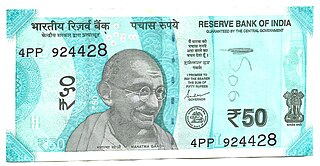
The is a denomination of the Indian rupee. The present ₹50 banknote in circulation is a part of the Mahatma Gandhi New Series of banknotes. However, ₹50 banknotes of the previous series will continue to be legal tender.

The Indian 20-rupee banknote is a common denomination of the Indian rupee. The current ₹20 banknote in circulation is a part of the Mahatma Gandhi New Series. The Reserve Bank introduced the ₹20 note in the Mahatma Gandhi New Series in 2019, making it the last denomination to be introduced in the series.

The Indian 10-rupee banknote is a common denomination of the Indian rupee. The ₹10 note was one of the first notes introduced by the Reserve Bank of India as a part of the Mahatma Gandhi Series in 1996. These notes are presently in circulation along with the Mahatma Gandhi New Series which were introduced in January 2018, this is used alongside the 10 rupee coin.

The 2000 rupee note was introduced by the Reserve Bank of India on 8 November 2016. The introduction of this denomination of the Indian rupee was part of the government's demonetization exercise aimed at curbing corruption, black money and counterfeit currency. On the same day, the Indian government announced the demonetization of the existing 500 rupee and 1000 rupee notes. The intention behind demonetization was to invalidate the old notes to disrupt illegal activities and promote a shift towards digital transactions.

The Mahatma Gandhi New Series of banknotes are issued by the Reserve Bank of India (RBI) as the legal tender of the Indian rupee, intended to replace the Mahatma Gandhi Series of banknotes. Announced on 8 November 2016, it followed the demonetisation of ₹500 and ₹1000 banknotes of the original Mahatma Gandhi Series. Similar to the preceding series of banknotes, the obverse of the Mahatma Gandhi New Series banknotes also prominently displays the portrait of Mahatma Gandhi. The logo of Swachh Bharat Abhiyan is also printed on the back of the banknotes of this series.

The Indian 200-rupee note (₹200) is a denomination of the Indian rupee. After the 2016 Indian banknote demonetisation, the new currency notes were announced by the Reserve Bank of India: ₹2,000, ₹500, ₹200, ₹100, ₹50, ₹20 and ₹10.

The Indian 5-rupee note is the second smallest Indian note in circulation. The Reserve Bank of India introduced the 5 rupee banknote as part of the Mahatma Gandhi Series in 1996. The printing of notes in the denominations of ₹5, however, has been discontinued as these denominations have been coinised but still these notes are valid legal tender in India.

The Lion Capital Series were a series of currency notes issued after India declared its independence from Great Britain and used until the Reserve Bank of India (RBI) introduced the Mahatma Gandhi Series in 1996 with banknotes in denominations of 10 and 500 rupees, and were designed with the image of the Lion Capital of Ashoka, the National Emblem which replaced the George VI banknote series. The first banknotes printed after India achieved its independence was a 1-rupee note.









